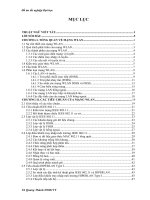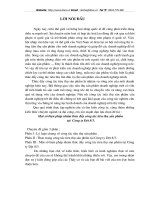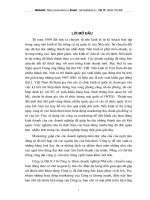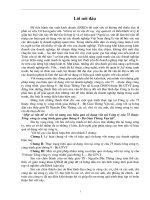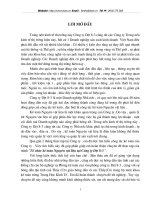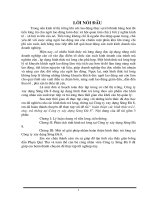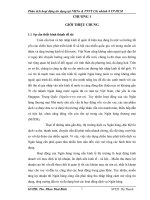COSY INFINITE VERSION 8 MAKINO
Bạn đang xem bản rút gọn của tài liệu. Xem và tải ngay bản đầy đủ của tài liệu tại đây (171.92 KB, 6 trang )
* Corresponding author: Fax: 1-517-353-5967.
E-mail address: (K. Makino)
Nuclear Instruments and Methods in Physics Research A 427 (1999) 338}343
COSY INFINITY version 8
Kyoko Makino*, Martin Berz
Department of Physics and National Superconducting Cyclotron Laboratory, Michigan State University, East Lansing, MI 48824, USA
Abstract
The latest version of the particle optics code COSY INFINITY is presented. Using Di!erential Algebraic (DA)
methods, the code allows the computation of aberrations of arbitrary "eld arrangements to in principle unlimited order.
Besides providing a general overview of the code, several recent techniques developed for speci"c applications are
highlighted. These include new features for the direct utilization of detailed measured "elds as well as rigorous treatment
of remainder bounds. 1999 Elsevier Science B.V. All rights reserved.
Keywords: Code; Di!erential algebraic method; Computation
1. The Code COSY
COSY INFINITY [1] is a code for the simula-
tion, analysis and design of particle optical systems,
based on di!erential algebraic (DA) methods [2}4].
Currently there are a total of about 270 registered
users.
The code has its own scripting language with
a very simple syntax [5]. For the utilization of DA
tools, the code is object oriented, and it allows
dynamic adjustment of types. The engine for DA
operations [6,7] is highly optimized for speed and
fully supports sparsity, which greatly enhances per-
formance for systems with midplane symmetry.
There are also conversion tools to transform any
lattice in standard MAD input or in the Standard
eXchange Format (SXF format) to a program in
COSY language. The compiled code can either be
executed directly or saved in a binary "le for inclu-
sion in a later code.
The compiler has a rigorous syntax and error
analysis and is comparable in speed to compilers
of other languages. The object oriented features of
the code are not only useful for the direct use of
the di!erential algebraic operations, but also for
other important data types including intervals and
the new type of remainder-enhanced di!erential
algebras.
2. Simultaneous integration of reference orbit
and map
Besides very special cases of simple elements, the
computation of a transfer map requires numerical
integration. In Refs. [2,8] it is shown how maps of
any order can be obtained for arbitrary "elds,
based on mere integration of suitable DA objects.
0168-9002/99/$ } see front matter 1999 Elsevier Science B.V. All rights reserved.
PII: S 0 1 6 8 - 9 0 0 2 ( 9 8 ) 0 1 5 5 4 - X
COSY uses a Runge Kutta integrator of order eight
with automatic step size control based on a sev-
enth-order scheme for this purpose. However, the
equations of motion of the map require the knowl-
edge of the momentary curvature of the reference
orbit, and under the presence of acceleration, the
momentary energy of the reference orbit. For prac-
tical systems, these quantities themselves are usu-
ally obtained via numerical integration.
An important simpli"cation of this approach was
recently introduced into COSY in connection with
the detailed study of high-order maps of acceler-
ating cavities. Since the real number reference orbit
motion and the DA transfer map motion are
coupled, the equations of motion for both reference
orbit and map were solved simultaneously as one
global set of equations. In this framework, part of
the di!erential equations are real, and part are DA.
In practice, this necessity greatly bene"ts from the
fact that COSY allows dynamic typing, i.e. the
adjustment of data types at run time, within
COSY's object oriented environment. In this way,
the map integration becomes more stable and, for
complicated accelerating structures, shows signi"-
cant computational e$ciency gains.
3. Standard fringe 5eld calculation
From its earliest versions, COSY has featured
various methods to account for fringe "eld e!ects in
the calculation, including the choice of model func-
tions to represent the fringe "elds. The standard-
ized model is based on the description of the
s-dependence of multipole strengths by an Enge
function
F(z)"
1
1#exp(a
#a
) (z/D)#2#a
) (z/D)
)
.
The pictures in Fig. 1 show the fringe "eld models
adopted by default in COSY for dipoles and for
quadrupoles. In both cases, the variable z measures
the distance to the e!ective "eld boundary. It co-
incides with the arc length s along the reference
trajectory in the case of multipoles, but in the case
of dipoles it takes into account tilts and curvatures
of the e!ective "eld boundary. D is the full aperture.
Besides the default Enge functions, the user can
load his own set of Enge coe$cients a
}a
.
The numerical integrator described in the pre-
vious section computes the e!ects of analytically
described fringe "eld exactly in the equations of
motion. As long as an analytical expression of the
fringe "eld is provided, COSY calculates even very
detailed fringe-"eld e!ects, but the computational
expense is prone to be higher than for main "eld
maps.
COSY also provides other approaches for the
computation of approximate fringe-"eld e!ects that
are much less costly computationally. The "rst one
uses approximate fringe "elds with an accuracy
comparable to the fringe-"eld integral method. The
other one is the SYSCA method, which uses a com-
bination of geometric scaling in TRANSPORT co-
ordinates and symplectic rigidity scaling [9,10]. It
uses parameter-dependent symplectic representa-
tions of fringe-"eld maps stored in "les. These can
either be produced by the user or taken from the
COSY shipment. This method computes fringe
"elds with very high accuracy at very modest cost.
Another feature available from the early days of
COSY is an element to compute the map of a gen-
eral optical element characterized by the values of
multipole strengths and reference curve and their
derivatives supplied at points along the indepen-
dent variable s. In principle, this element can be
used for the calculation of any particle optical sys-
tem. But in practice, it "rst requires the determina-
tion of the curvature as a function of s, which often
requires numerical integration. Furthermore, it is
necessary to provide high-order derivatives, which
are frequently not readily available.
4. The azimuthally dependent sector magnet
While COSY has a large library of electromag-
netic elements, sometimes it is necessary to allow
for a more detailed description of the "eld. An
important example is the precise analysis required
for modern nuclear spectrographs. In such a case,
a custom-made COSY element with an analytically
described "eld model can help, but sometimes there
is no other way than utilizing the measured "eld
data in the computation, which has to be supplied
K. Makino, M. Berz / Nuclear Instruments and Methods in Physics Research A 427 (1999) 338}343 339
Fig. 1. Fringe "eld model by Enge function for dipoles (top) and quadrupoles (bottom) by default in COSY. The horizontal axis denotes
z/D. Pictures are generated with COSY's graphics environment.
to the equations of motion in an appropriate way
to be integrated by the DA integrator discussed
earlier.
The methods we will discuss in this section are
used extensively in the simulation of the S800
Spectrograph at the National Superconducting
340 K. Makino, M. Berz / Nuclear Instruments and Methods in Physics Research A 427 (1999) 338}343
Fig. 2. The Quadrupole, Duodecapole, and 20 pole strengths in
the fringe "elds of the LHC High Gradient Quadrupoles.
Cyclotron Laboratory at Michigan State Univer-
sity [11], which uses the approach of high-order
reconstructive correction [12] in COSY to achieve
its high-energy resolution, as well as the various
spectrographs at the other laboratories. The de-
tailed "eld description of huge bending magnets is
key to the precise analysis of such a system, and
a rough estimate in the S800 case shows a need of
a relative accuracy of 10
\
of the "elds.
The conventional bending magnets in COSY are
a homogeneous dipole with edge angles and curva-
tures at entrance and exit, an inhomogeneous
bending magnet with the midplane radial "eld de-
pendence given by
F(x)"F
1!
G
n
G
x
r
G
where r
is the bending radius, and an in-
homogeneous bending magnet with shaped en-
trance and exit edges. To this main "eld model,
Enge-type fringe "elds are tacked on. A new bend-
ing magnetic element in COSY allows to specify the
two-dimensional structure of the main "eld in polar
coordinates via
F(r, )"
G
H
A
GH
(r!r
)
G
(!
/2)
H
where
is the angle of de#ection of the element.
For the description of edge e!ects, Enge-type fringe
"eld e!ects as well as the consideration of edge
angles and curvatures at entrance and exit are
included.
Another yet more comprehensive way to treat
complicated bending magnets is based on direct
speci"cation of measured "eld data [5,13].
5. The multipole based on tabulated data
In some instances it is not possible to rely on
simple models for the description of the fringe "elds
of multipoles. An important case in point is the
study of the High Gradient Quadrupoles of the inter-
action regions of the LHC. Fig. 2 shows the behav-
ior of the quadrupole strength as well as the 12 and
20 pole strengths. Because of the complicated
structure, "tting the quadrupole term merely with
Enge functions is di$cult, and clearly the higher
order terms are not very amenable to detailed de-
scription by Enge functions.
For such purposes when there is no good ana-
lytical model available to describe the "eld, it
is desirable to directly utilize measured "eld data
for the computation of the map. Following the
K. Makino, M. Berz / Nuclear Instruments and Methods in Physics Research A 427 (1999) 338}343 341
Fig. 3. Gaussian wavelet representation for f (x)"1 (left) and f (x)"exp(!x) (right). Pictures are generated with COSY's graphics
environment.
conventional DA integration scheme to obtain
maps to arbitrary order [8], it is necessary to know
both the multipole strengths as well as their higher
order derivatives. Thus, an interpolation based on
measured multipole terms has to assure di!erentia-
bility. The Gaussian wavelet representation
F(x)"
,
G
A
G
1
(S
exp
!
(x!x
G
)
x
S
(1)
has proven very well suited for this purpose, while
at the same time providing localization and adjust-
able smoothing of the data. In Eq. (1), A
G
are the
values of data at N equidistant points x
G
spaced by
the distance x, and S is the control factor of the
width of Gaussian wavelets. Pictures in Fig. 3 show
the Gaussian interpolation of one dimensional
functions as a sum of Gaussian wavelets for a
constant function f (x)"1 and a non-constant
function, as an example, a Gaussian function
f (x)"exp(!x
).
The method can also be extended to allow for
a two-dimensional description of measured "eld
data in the midplane that is often available for
high-quality bending magnets like those of the S800
[5,13]. The time consuming summation over all
the Gaussians, especially in two-dimensional case,
can take an advantage of the quick fall-o! of
the Gaussian function, hence the summation of
only the neighboring Gaussians is enough for the
accuracy yet greatly improves the computational
e$ciency.
6. Remainder-enhanced di4erential algebraic
method and other features
The highlight of version 8 of COSY from the
perspective of computational mathematics is a new
technique, the remainder-enhanced di!erential al-
gebraic (RDA) method, which computes rigorous
bounds for the remainder terms of the Taylor ex-
pansions along with the Taylor polynomials. The
details of the method are found in Refs. [14}17].
For beam physics, it opens the capability of the
determination of rigorous bounds for the remain-
der term of Taylor maps [18], and it can estimate
guaranteed stability times in circular accelerators
combined with methods to determine approximate
invariants of the motion [19,20].
Other features in COSY include methods for
symplectic tracking [2,21], normal forms [2,22],
tools used for the design of "fth-order achromats
[23,24], and the analysis of spin motion [25,26],
which has gained importance connected to the de-
sire to accelerate polarized beams. There are also
various technical tools including a new interactive
graphics based on PGPLOT. The demo "le of the
code, which is a part of the COSY shipment, pro-
vides a good overview over the key features in
beam physics.
Acknowledgements
The authors are grateful for the e!orts that
a large number of users have made towards the
342 K. Makino, M. Berz / Nuclear Instruments and Methods in Physics Research A 427 (1999) 338}343
development of COSY. Financial support for
the development of the theoretical tools behind the
code were provided by the US Department of
Energy and the Alfred P. Sloan Foundation.
References
[1] M. Berz, COSY INFINITY Version 8 reference manual,
Technical Report MSUCL-1088, National Superconduct-
ing Cyclotron Laboratory, Michigan State University,
East Lansing, MI 48824, 1997, see also m-
theory.nscl.msu.edu/cosy.
[2] M. Berz, High-order computation and normal form analy-
sis of repetitive systems, in: M. Month (Ed.), Physics of
Particle Accelerators, AIP 249, American Institute of
Physics, 1991, p. 456.
[3] M. Berz, Part. Accel. 24 (1989) 109.
[4] M. Berz, Nucl. Instr. and Meth. A 298 (1990) 426.
[5] K. Makino, M. Berz, COSY INFINITY Version 7, In:
Fourth Computational Accelerator Physics Conference,
vol. 391, AIP Conference Proceedings, 1996, p. 253.
[6] M. Berz, Forward algorithms for high orders and many
variables, in: Automatic Di!erentiation of Algorithms:
Theory, Implementation and Application, SIAM, 1991.
[7] M. Berz, Computational Di!erentiation, Entry in Encyclo-
pedia of Computer Science and Technology, Marcel
Dekker, New York, 1999.
[8] M. Berz, Modern map methods for charged particle optics,
Nucl. Instr. and Meth. 363 (1995) 100.
[9] G. H. Ho!staK tter, Rigorous bounds on survival times in
circular accelerators and e$cient computation of fringe-
"eld transfer maps, Ph.D. thesis, Michigan State Univer-
sity, East Lansing, Michigan, USA, 1994, also DESY
94-242.
[10] G. Ho!staK tter, M. Berz, Phys. Rev. E 54 (1996) 4.
[11] J. Nolen, A.F. Zeller, B. Sherrill, J.C. DeKamp, J. Yurkon,
A proposal for construction of the S800 spectrograph,
Technical Report MSUCL-694, National Superconduct-
ing Cyclotron Laboratory, 1989.
[12] M. Berz, K. Joh, J.A. Nolen, B.M. Sherrill, A.F. Zeller,
Phys. Rev. C 47 (2) (1993) 537.
[13] K. Makino, M. Berz, Arbitrary order aberrations for ele-
ments characterized by measured "elds, in: Proc. SPIE,
vol. 3155 (1997) 221.
[14] M. Berz, G. Ho!staK tter, Reliable Comput. 4 (1998) 83.
[15] K. Makino, M. Berz, Remainder di!erential algebras and
their applications, in: M. Berz, C. Bischof, G. Corliss,
A. Griewank (Eds.), Computational Di!erentiation: Tech-
niques, Applications, and Tools, SIAM, Philadelphia,
1996, pp. 63}74.
[16] M. Berz, Di!erential algebras with remainder and rigorous
proofs of long-term stability, in: Fourth Computational
Accelerator Physics Conference, vol. 391, AIP Conference
Proceedings, 1996, p. 221.
[17] K. Makino, Rigorous analysis of nonlinear motion in
particle accelerators, Ph.D. thesis, Michigan State Univer-
sity, East Lansing, Michigan, USA, 1998, also MSUCL-
1093.
[18] M. Berz, K. Makino, Reliable Comput. 4 (1998) 361.
[19] M. Berz, From Taylor series to Taylor models, AIP 405,
American Institute of Physics, 1997, p. 1.
[20] M. Berz, G. Ho!staK tter, Interval Comput. 2 (1994)
68.
[21] M. Berz, Symplectic tracking in circular accelerators with
high-order maps, in: Nonlinear Problems in Future
Particle Accelerators, World Scienti"c, Singapore, 1991,
p. 288.
[22] M. Berz, Di!erential algebraic formulation of normal form
theory, in: M. Berz, S. Martin, K. Ziegler (Eds.), Proceed-
ings of the Nonlinear E!ects in Accelerators, IOP Publish-
ing, 1992, p. 77.
[23] W. Wan, Theory and applications of arbitrary-order
achromats. Ph.D. thesis, Michigan State University, East
Lansing, Michigan, USA, 1995, also MSUCL-976.
[24] W. Wan, M. Berz, Phys. Rev. E 54 (3) (1996) 2870.
[25] M. Berz, Di!erential algebraic description and analysis of
spin dynamics, in: Proceedings, SPIN94, 1995.
[26] V. Balandin, M. Berz, N. Golubeva, Computation and
analysis of spin dynamics, in: Fourth Computational
Accelerator Physics Conference, vol. 391, AIP Conference
Proceedings, 1996, p. 276.
K. Makino, M. Berz / Nuclear Instruments and Methods in Physics Research A 427 (1999) 338}343 343
